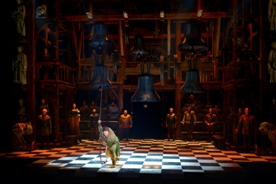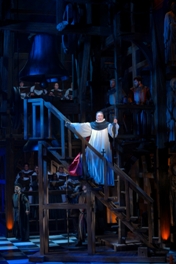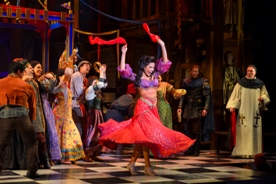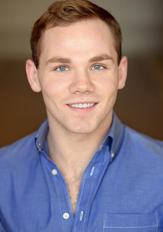
From family-friendly animated funfest to powerful grown-up fare, Disney’s The Hunchback Of Notre Dame has been transformed by the folks at La Jolla Playhouse into a new stage musical so darkly dramatic that Broadway’s Phantom Of The Opera seems almost light and frothy by comparison. In other words, what they’ve come up with is that rarity—a Disney musical with the proviso “Leave the kids at home.”
 To be fair, this Hunchback (produced in association with New Jersey’s Paper Mill Playhouse and billed as “based on the Victor Hugo novel with songs from the Disney film”) has none of the movie’s five screenwriters receiving program credit, only about half of its Alan Menkin/Stephen Schwartz songs imported from the movie, and just a few of the film’s central conceits remaining to remind us of its animated predecessor.
To be fair, this Hunchback (produced in association with New Jersey’s Paper Mill Playhouse and billed as “based on the Victor Hugo novel with songs from the Disney film”) has none of the movie’s five screenwriters receiving program credit, only about half of its Alan Menkin/Stephen Schwartz songs imported from the movie, and just a few of the film’s central conceits remaining to remind us of its animated predecessor.
Scenic designer Alexander Dodge’s cathedral-like set along with choral ensemble Sacra/Profana’s curtain-to-curtain onstage presence cue us in from the get-go to the musical’s tonal shift from screen to stage, and though we do go “Out There” for the festivities of the “Topsy Turvy” Festival Of Fools (and the bounciest of Chase Brock’s multiple choreographic contributions), we, like Quasimodo, stay pretty much behind the “parapets of stone” our hunchbacked hero sings about in one of the Disney film’s best-known and most drop-dead gorgeous songs.
As for the trio of gargoyles who provided animated Quasimodo with his sole companionship (and movie audiences with plenty of quirky comic relief), though the talking gargoyle concept remains, the schticky Victor, Hugo, and LaVerne—and their show-stopping “A Guy Like You”—are gone.
 Briefly put, the best way to enjoy The Hunchback Of Notre Dame The Musical is to cast aside any preconceived notions of what you may have seen on the big screen in 1996 (or on home video since then) and simply allow yourself to be swept away by the power of the Victor Hugo original, any synopsizing of which will be foregone here on the assumption that anyone perusing this review has either read Hugo’s novel or seen one of its umpteen film or TV adaptations, most famously the 1923 silent starring Lon Chaney or its 1939 sound remake with Charles Laughton in the title role.
Briefly put, the best way to enjoy The Hunchback Of Notre Dame The Musical is to cast aside any preconceived notions of what you may have seen on the big screen in 1996 (or on home video since then) and simply allow yourself to be swept away by the power of the Victor Hugo original, any synopsizing of which will be foregone here on the assumption that anyone perusing this review has either read Hugo’s novel or seen one of its umpteen film or TV adaptations, most famously the 1923 silent starring Lon Chaney or its 1939 sound remake with Charles Laughton in the title role.
The sassy trio of Victor, Hugo, and LaVerne may have been evicted from the La Jolla Playhouse stage, but humanized gargoyles remain, portrayed by the musical’s dozen ensemble members, the stone sculptures allowing book writer Peter Parnell and director par excellence Scott Schwartz to give us glimpses of the inner Quasimodo, i.e. minus the guttural, slurred-speech that makes the world see him as “outsider” or “freak” or worst of all “monster.”
A back-story quite distinct from the Disney flick introduces us to Quasimodo (understudy Julian R. Decker) as the orphaned nephew of chief villain Claude Frollo (Patrick Page) and son of Frolo’s younger brother Jehan (Lucas Coleman) and his gypsy lover Florika (Samantha Massell).
 As for the sultry Esmeralda (Ciara Renée), Hunchback The Musical sticks closer to film by introducing us to the seductive gypsy on Quasimodo’s excursion to the annual Festival Of Fools, where he also meets the handsome Captain Pheobus (Andrew Samonsky), who finds himself competing with Quasi’s affection for Esme and Frolo’s lust for her—said lust being tops among reasons for parents of preteens to hire a babysitter before heading off for a night at the theater.
As for the sultry Esmeralda (Ciara Renée), Hunchback The Musical sticks closer to film by introducing us to the seductive gypsy on Quasimodo’s excursion to the annual Festival Of Fools, where he also meets the handsome Captain Pheobus (Andrew Samonsky), who finds himself competing with Quasi’s affection for Esme and Frolo’s lust for her—said lust being tops among reasons for parents of preteens to hire a babysitter before heading off for a night at the theater.
Alan Menken/Stephen Schwartz fans can rejoice that almost all of the film’s original songs remain, gorgeously performed by a cast of Broadway vets and (at the performance reviewed) by one sensational 2014 BFA grad. “Out There” in particular remains an emotion-packed showstopper, while “Somewhere” and “God Help The Outcasts” (which backed up end title credits in the movie) gain new resonance as plot-propelling songs performed by Pheobus and Esmeralda. (Only “A Guy Like You” has fallen onto the cutting room floor along with its trio of cartoonish gargoyle vocalists.)
By contrast, brand-new Menken-Schwartz ditties like “Rest and Recreation” and “Flight Into Egypt” serve mostly to pad the film’s original running time by an additional half hour, though additional listens might prove them “growers.”
Hunchback The Musical seems conceived expressly to appeal to Phantom Of The Opera fans in both its characters (deformed hero, seductive heroine, and handsome rival for her love) and tone, with a bit of Sweeney Todd’s lust-possessed Judge Turpin thrown in for good measure in the person of the evil Frolo. If anything, Hunchback ends up darker than either Phantom or Sweeney, offering little or no comic relief along the way to an ending that proves more Victor than Walt.
Still, regardless of tone or treatment, it’s hard not to be gripped by this centuries-old underdog tale, whether witnessing Quasimodo’s public humiliation at the hands of an intolerant populace or seeing the equally demonized Esmeralda and her fellow gypsies. Simply put, this is one musical likely to resonate with anyone who’s ever felt victimized by fear-induced prejudice.
Even so, Hunchback The Musical would not be nearly as powerful as it is without its superb lead performers and Broadway-caliber ensemble.
 It goes without saying that there could be no Hunchback Of Notre Dame without a Quasimodo to remember, and in Cincinnati Conservatory Of Music Class Of 2014 grad Decker, the role usually played by Broadway/TV star Michael Arden is in supremely qualified hands.
It goes without saying that there could be no Hunchback Of Notre Dame without a Quasimodo to remember, and in Cincinnati Conservatory Of Music Class Of 2014 grad Decker, the role usually played by Broadway/TV star Michael Arden is in supremely qualified hands.
With only the smearing on of some face paint, the addition of strap-on hump and an abundance of talent, Decker transforms himself from handsome young leading man (he played Jean Valjean in CCM’s Les Miz earlier this year) to misshapen “monster” with the heart and soul (and voice) of an angel. Decker’s is a star performance of the first magnitude, and I feel fortunate to have been able to witness it.
As Frolo, an extraordinary Page takes what in lesser hands could be nothing more than your average everyday sexually twisted villain and gives us glimpses both of his corrupted humanity and his licentious soul. Add to that as sonorous a speaking voice and as resonant a pair of vocal chords as you’re likely to have heard in many a moon and you’ve got one hell of a multifaceted villain.
Renée proves a stunning Esmeralda with exquisite pipes to match opposite Ventura native-turned-Broadway star Samonsky as a dashing, vocally blessed Phoebus (though the latter deserves a clearer fate than Parnells book gives him).
Erik Liberman invests narrator Clopin with considerable charm and panache, Neal Mayer does heady work as Saint Aprodisius, and San Diego favorite Coleman makes the most of his time as Jehan before joining the ranks of fellow ensemble members Ian Patrick Gibb (Charlus), Beth Kirkpatrick (Madam), William Michals (Father Dupin), and Richard Ruiz (King Louis XI), along with William Thomas Hodgson, Massell, Nora Menken, Anise Ritchie, Vincent Rodriguez III, and Brian Smolin, bona fide triple threats each and every one, with the sublime harmonies of Sacra/Profana offering audiences the next best thing to having the Mormon Tabernacle Choir in the house. Mary Joe Duggan and Christian Villanueva are swings.
Top marks go to musical supervisor/arranger Michael Kosarin, music director Brent-Alan Huffman, orchestrator Michael Starobin, and dance music arranger Rob Berman.
Scenic designer Dodge’s expansive cathedral of a set, lit to moody perfection by lighting designer Howell Binkley, is about the furthest thing imaginable from Disney’s Beauty And The Beast’s Technicolor wonders, but it is precisely what the creative team must have had in mind in conceiving their more somber reimagining of what Disney animators gave us back in ‘96.
Alejo Vietti’s terrific costumes provide gratifying snatches of color in the cast’s gypsy wear, though the gargoyles’ simple gray smocks may leave audiences confused about just who Quasimodo’s chime-ringing companions exactly are.
Highest praise goes also to sound designer Gareth Owen, hair and wig designer Charles G. LaPointe, and fight director Steve Rankin.
Casting is by Tara Rubin Casting, aided by local casting director Teresa Sapien. (La Jolla Playhouse deserves credit for not casting entirely “out of New York.”)
M. William Shiner is production stage manager and Becky Fleming and Jennifer Kahn are assistant stage managers.
Considering how many Disney movie hits have made it to Broadway in the two decades since Beauty made her NYC debut opposite her Beast, it’s a fair bet to assume that producers are hoping for Hunchback too to make it to The Great White Way.
So long as audiences go in with appropriate expectations (and minus anyone too young to babysit for him or herself), Quasimodo’s short, chubby legs might just carry The Hunchback Of Notre Dame to New York as well.
La Jolla Playhouse, 2910 La Jolla Village Drive, La Jolla.
www.LaJollaPlayhouse.org
–Steven Stanley
November 20, 2014
Production stills: Kevin Berne
Tags: Alan Menken, La Jolla Playhouse, San Diego County Theater Review, Stephen Schwartz, Victor Hugo



 Since 2007, Steven Stanley's StageSceneLA.com has spotlighted the best in Southern California theater via reviews, interviews, and its annual StageSceneLA Scenies.
Since 2007, Steven Stanley's StageSceneLA.com has spotlighted the best in Southern California theater via reviews, interviews, and its annual StageSceneLA Scenies.







 COPYRIGHT 2024 STEVEN STANLEY :: DESIGN BY
COPYRIGHT 2024 STEVEN STANLEY :: DESIGN BY